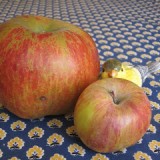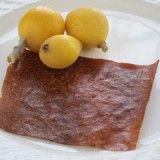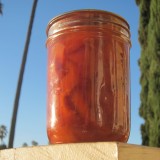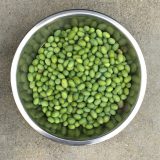This week we were luck enough to tag along with Tara Kolla of Silver Lake Farms on a jaunt to the hills near Tehachapi to help harvest an allusive fruit called the medlar. Erik and I were just extra hands–the plan was hatched between Tara and Craig Ruggless of Winnetka Farms. See, Craig has a place up in those hills, and just happened to know his neighbors had a little grove of medlars, and these neighbors agreed to sell them to Craig and Tara, provided Craig and Tara picked them. For us, it was a great excuse for a trip to the mountains with a bunch of friends for some laughs, fresh air and gorgeous fall scenery. Also along for the medlar hunt were Joseph Shuldiner and Graham Keegan. As a group we gathered 100 lbs of medlars in a couple of hours of easy work, which are going to be sold to foodies, rare fruit enthusiasts and perhaps some enterprising chefs at this weekend’s Santa Monica Farmers Market. There’s an article about medlars and this particular expedition in todays’s LA Times.
What is a medlar, you ask? It‘s Mespilus germanica, a small deciduous tree and member of the rose family. In fact, to me, medlar fruit look exactly like giant rosehips. The fruit is smallish, ranging from about 1 to 2 inches in diameter, and ranging in color from rosy rust to dusty brown.
Medlars are native to Southwestern Asia and Southeatsern Europe. They were enjoyed by the Greeks and Romans, doted on by Victorians and mentioned by Shakespeare. I believe they are still popular in their native lands, such as Iran and Turkey. However, they’re almost unknown in the U.S. today, primarily, I suspect, for two reasons. Reason #1 is that they have to be eaten when almost rotten–a process properly called “bletting”–similarly to how you have to wait for Hachiya persimmons to soften before you can eat them. This leads to reason #2, because medlars have to be eaten when bletted, they either have to be eaten right off the tree, or they have to be picked early, then put aside for a few weeks to blet. Then, when they’re finally bletted, they’re have to be eaten immediately. There’s not a huge window of edibility. This level of persnickety-ness just doesn’t jive with our industrial food distribution system.
 Beyond that, when they’re ready to eat, they look like they’re ready for the compost heap–brown, squishy, a little wrinkly. It takes some getting used to–well, it takes about as long for you to eat your first one before you figure out rotten=darn good. I’d describe them as tasting like really good apple butter. People will describe them as holding delicate notes of cinnamon, vanilla, cider, wine, etc. I don’t know about that–I just tasted really, really good apple butter, delivered to me in a convenient skin instead of on toast. The flesh even looks like apple butter. Of course, like all persnickety fruits, they have a few big seeds that you have to work around as well–sort of suck clean and spit out later. It’s worth it, though.
Beyond that, when they’re ready to eat, they look like they’re ready for the compost heap–brown, squishy, a little wrinkly. It takes some getting used to–well, it takes about as long for you to eat your first one before you figure out rotten=darn good. I’d describe them as tasting like really good apple butter. People will describe them as holding delicate notes of cinnamon, vanilla, cider, wine, etc. I don’t know about that–I just tasted really, really good apple butter, delivered to me in a convenient skin instead of on toast. The flesh even looks like apple butter. Of course, like all persnickety fruits, they have a few big seeds that you have to work around as well–sort of suck clean and spit out later. It’s worth it, though.
We can’t grow medlars here in Los Angeles–it’s too warm. Otherwise I’d plant one right now. Medlars need hot summers and cold, frosty winters. If you live in a place like that, I’d highly recommend you plant a medlar. It’s a small, attractive tree, topping out at about 10 feet, and can be kept bush size. The ones we were harvesting were only 4-6 feet high. They are not widely available, but Raintree Nursery has a selection here.
After the jump is a little photo gallery from our trip:
 |
| Craig sorting medlars in the grand countyside |
 |
| Is this bletted? Tara giving the medlar an evaluating eye |
 |
|
| Medlars have beautiful fall foliage, and the fruit remains on the tree after the leaves fall, which is quite striking |
 |
|||
| Graham, looking more stylin’ than me as he works. |
 |
| Here’s Joseph. He’s writing a cookbook. Notice how the trees are kept small for easy picking. |
 |
||
| All sorted. Getcha medlars here! |
 |
| medlars to market |








Cool! I’ve actually heard of medlars, but then, I’m a gardening geek. I’m funny about rotten fruit, so I think I’d probably make some sort of steamed pudding with them, or cook them into a butter I could put up, rather than eating them freshly bletted. They sound like they’d go really well with the right cheese and the right dessert wine, though.
We have a Medlar in our front yard that I planted this past year. I wrote a similar post awhile back about them. I was super excited when we were in the UK to come across a very old specimen.
PLEASE CONTACT BILL GERLACH AT MELISSA’S WORLD VARIETY PRODUCE ABOUT YOUR CROP
I wonder if it wouldn’t be worthwhile to just -try- planting one where you are. Dave Wilson nurseries had a little youtube video about an experimental apple orchard in Riverside where the grower planted all sorts of varieties that required hundreds of hrs of chill. But they were doing fine and their fruit was delicious. http://www.youtube.com/watch?v=5jwtYhS2Qcs
If you have a bare patch in your garden you could always experiment…and I read somewhere (maybe the Raintree catalog, maybe One Green World in Oregon?) that they used to be espaliered along castle walls – that’d take up even less room…!
PS, been lurking for a while. I’m up in the Bay Area but grew up in Silver Lake close to the new library. It’s neat to see garden and food news from my old stomping grounds.
Rena: Thanks! It’s good to hear from someone from the neighborhood. I do know that apples can adapt to low chill hours, but I believe the medlar needs frost, and we’re lucky if we get one frosty night a year here. But we might ask some of our fruit expert friends and see what they think.
I was able to grow medlars down here in San Diego county with no problems. They were grafted on a pear tree and eventually fire blight killed the limbs they were on so I lost them. We are in a colder spot but still are only about 15 – 20 miles inland from the coast. If you have an existing pear tree you may want to graft medlar onto that so you don’t have to plant a whole tree to see if they will do well in your area. Make sure you sterilize pruning tools and grafting knives between cuts and do not share infected scion wood. This will help to control fireblight. If it does develop cut it out a couple of inches down into non-infected wood before it takes further hold.
Hi, I love medlars! Just made my first batch of medlar jam last month and it is great–it tastes of smoke and autumn.
about two years ago on my now defunct blog i blogged about the medlar tree http://anduhrew.blogspot.com/search/label/Forgotten%20Fruits. great tree for mediterranean climates like ours.
Every time I design a garden I always push for medlar trees. We even have one in the Chino Creek wetlands and educational park where i work and we’re hoping to get a few in some school gardens this school year.
Operative: We don’t have pear trees–and I don’t know anyone who’s growing them in our area. I don’t think they like it here.
We’re going to look into the growing conditions for medlar more and report back, because lord knows I’d love to have one. Erik is also finding lots of cool cultural tidbits to share, so I think “Medlar Mania” will continue on this blog for a while longer.
Anduhrew:
I love your “Forgotten Fruit” blog series. The cashew fruits are blowing my mind. I had no idea. Seriously, everyone, you should check it out:
http://anduhrew.blogspot.com/search/label/Forgotten%20Fruits
Thank you for writing this article. There is a tree on the Bronson Canyon trail up by the Hollywood sign that I pass when I run in the mornings. I always wondered what it was. After reading your article and looking up pics online I am sure it is a Medlar. It had LOTS of fruit on it this year. I don’t think it frosts there either and it looks very healthy.
Hey great post, I didn’t know the english name for these, one of our local urban farmers always gives me some of these but he is Italian and I guess a Chinese friend got him growing them. Thanks for all the info-yum!
@Ben:
You’ve got to pick a few fruits and report back on their flavor! Just take a few home and leave them sitting around til they go soft. I’d love to hear how the fruit of a LA tree tastes.
Pingback: Meddler | English Language Tutorials
i have one in front of my house,the very first year i had fruits from it ,i love my medlar tree
Pingback: First fruits | Portland Tree Tour
I have known of these since very young and love them.They used to be imported from Cyprus to UK where I lived. Strange that nobody in Cyprus these days has heard of them or even seen one before, I’ve seen the trees growing wild up in the mountains there.
Pingback: Les drupes de mes nèfliers (Medlar tree) de Bourdoux, mes piridions ! | saint yrieix la perche
Fascinating article. Just had this fruit, dried, in some home-made Chinese food.
Important edit for the site, though: You mean “elusive,” not “allusive,” in the 3d line. “Allusive” means referring or alluding to something (often literary), while “elusive” means hard to find.
Does anybody know how many chill hours (chilling time) the medlar requires to produce fruit?
Pingback: A Medlar Tree | tangent ramblings
I don’t know about apple butter, and I’m certainly not going to talk about hints of cinnamon or something else. The only thing that came to my mind was “oh, so that’s what a medlar tastes like”, and from that point on it’s always been “it tastes like a medlar”.
I first encountered medlars in England – the cathedral garden at Wells, to be precise – where I came across one and recognized it immediately from photographs. Fortunately it was late fall and apparently nobody had been close to it that year who had much of a clue about the fruit. There were a few lying on the ground, squashed. The first one I picked, I didn’t know… my fingers squished right through it. I licked them, liked what I tasted, and ate a few more. I later found out that a medlar tree was mentioned in Cathedral documents as long ago as 1326 AD. Maybe this tree was the same one, or a direct descendant. I don’t know. Yes, the fruit looked like it had been left around for a long time, but not quite as long as that.
The next time I see one, it had better be in the fall, otherwise I shall schedule a visit around that time. I kid you not.
I live in Iowa and I planted a medlar about 5 years ago. It has been very slow to grow. I got the nerve to eat my first one last fall and now I cannot wait to have them again.
Pingback: Citrus limetta, a.k.a. Sweet Lemon, a.k.a. Sweet Lime | Root Simple
I don’t know about Turkey and Iran, but they are well known here in the Balkans. Those itty bitty trees in the pictures are so cute/funny!